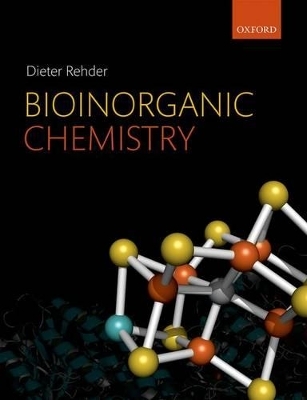
Bioinorganic Chemistry
Oxford University Press (Verlag)
978-0-19-965519-9 (ISBN)
Bioinorganic chemistry lies at the interface of inorganic chemistry and biochemistry, and explores the function of inorganic species in living systems - from the iron that helps our red blood cells transport oxygen to our tissues, to the calcium that forms an integral part of our bones.
In his book, Rehder provides a broad overview of this dynamic field, reviewing the key chemical elements that have important biological function, and exploring how the chemistry of these elements is central to the function of biological systems.
With sidebars that both review underlying principles of importance to the subject - including the concepts of magnetism and chirality - and discuss some of the analytical approaches that have enabled us to elucidate the biological role of the chemical elements, Bioinorganic Chemistry is the ideal resource for those discovering the field for the first time, and who need a clear, balanced account of the subject.
Online Resource Centre
The Online Resource Centre to accompany Bioinorganic Chemistry features figures from the book in electronic format, for use in lecture slides and other teaching materials.
Dieter Rehder is a Professor in the Institute of Inorganic and Applied Chemistry, University of Hamburg where his main fields of research include organometallic, bioinorganic and medicinal chemistry (of vanadium), oxido- and sulfidometal clusters, and metal NMR. Dieter was winner of the Vanadis Award 2006 for outstanding research in the field of vanadium chemistry.
Introduction ; 1. Bio-Elements in the Periodic Table ; 2. Pre-Life and Early Life Forms; extremophiles ; 3. The Alkaline and Alkaline Earth Metals ; 3.1 Overview ; 3.2 Ion Channels ; 3.3 Sodium and Potassium ; 3.4 Magnesium ; 3.5 Calcium ; 4. Iron: General Features of its Inorganic Chemistry and Biochemistry ; 4.1 General, and Aqueous Chemistry ; 4.2 Mobilization, Transport, Delivery, and Mineralization of Iron ; 5. Oxygen Transport and the Respiratory Chain ; 5.1 Oxygen and oxygen transport by haemoglobin and myoglobin ; 5.2 Oxygen transport by hemerythrin and haemocyanin ; 5.3 The Respiratory Chain ; 6. Oxidoreductases Based on Iron, Manganese, and Copper ; 6.1 Ribonucleotide Reductases ; 6.2 Superoxide dismutases, superoxide Reductases, and peroxidases ; 6.3 Oxygenases and oxidases ; 7. Oxo-transfer Proteins Based on Molybdenum, Tungsten, and Vanadium ; 7.1 Molybdo- and Tungsto-pyranopterins ; 7.1.1 The Xanthine Oxidase Family ; 7.1.2 The Sulfite Oxidase Family ; 7.1.3 The Dimethylsulfoxide (DMSO) Reductase Family ; 7.2 Vanadate-dependent Haloperoxidases ; 7.3 Model Chemistry ; 8. The Sulfur Cycle ; 8.1 Environmental Sulfur Cycling ; 8.2 Biogenic Metabolism of Sulfur ; 9. Nitrogenase and Nitrogen Cycle Enzymes ; 9.1 Overview and Native Nitrogenase ; 9.2 Nitrogenase Models and Model Reactions ; 9.3 Denitrification ; 9.4 Nitric Oxide ; 10. The Methane Cycle and Nickel Enzymes ; 10.1 Introduction ; 10.2 Methanogenesis ; 10.3 Biogenic Oxidation of Methane ; 10.4 Nickel Enzymes not Involved in Methane Metabolism ; 11. Photosynthesis ; 11.1 Overview ; 11.2 The Reaction Pathway ; 11.3 Modeling Photosynthesis ; 12. The Biochemistry of Zinc ; 12.1 An Overview of Zinc ; 12.2 Zinc Enzymes ; 12.2.1 Carboanhydrases ; 12.2.2 Hydrolases ; 12.2.3 Alcohol Dehydrogenase ; 12.3 The Role of Zinc in the Transcription of Genes ; 12.4 Thioneins ; 13. Metal- and Metalloid-Carbon Bonds ; 13.1 Organometallic Compounds of Transition Metals ; 13.2 Carbon Bonds to Main Group Metals and Metalloids ; 14. Inorganics in Medicine ; 14.1 Metals and Metalloids: An Introduction ; 14.2 Dysfunction of Iron and Copper Homeostasis ; 14.2.1 Iron ; 14.2.2 Copper ; 14.3 Metals and Metalloids in Therapy ; 14.3.1 Historical and General Notes ; 14.3.2 Treatment of Arthritis with Gold Compounds ; 14.3.3 Cancer Treatment ; 14.3.4 Further Metal Based Medications ; 14.3.5 Radiopharmaceuticals ; 14.4 Metals and Metalloids in Diagnostic Imaging ; 14.5 The Toxic and Therapeutic Potential of CO, NO and H2S
| Zusatzinfo | 225 illustrations |
|---|---|
| Verlagsort | Oxford |
| Sprache | englisch |
| Maße | 189 x 245 mm |
| Gewicht | 430 g |
| Themenwelt | Naturwissenschaften ► Biologie ► Biochemie |
| Naturwissenschaften ► Chemie ► Anorganische Chemie | |
| ISBN-10 | 0-19-965519-7 / 0199655197 |
| ISBN-13 | 978-0-19-965519-9 / 9780199655199 |
| Zustand | Neuware |
| Informationen gemäß Produktsicherheitsverordnung (GPSR) | |
| Haben Sie eine Frage zum Produkt? |
aus dem Bereich


